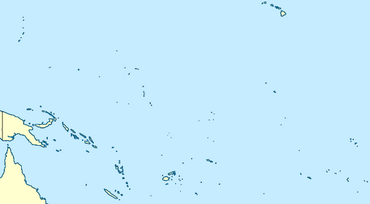History
The church's first missionaries visited Fiji in 1953. The church's first recorded meeting was held July 25, 1954, in the Matanisiga Hall in Toorak, Suva. [7] After visiting the island in 1955, church president David O. McKay, opened its first branch in Fiji, calling missionaries to increase outreach to Fijians and Indians. [7] In 1975, the church's Fiji Technical College was opened. The Suva Fiji Stake, the country's first, was organized 12 June 1983, with Inosi Naga as president. Stakes were later created in Viti Levu and districts in Vanua Levu and Taveuni as membership grew. The number of congregations increased from 19 t0 41 in the 1990s. [7]
On April 5, 1998, church president Gordon B. Hinckley announced that a temple would be built in Fiji. [3] The site in Suva was announced on May 7, 1998. [4]
A groundbreaking ceremony were held for the temple on May 8, 1999. Earl M. Monson, a member of the Second Quorum of the Seventy, presided at the ceremony. [8] The site chosen for the temple was 4.7 acres (19,000 m2), with the Pacific Ocean visible from three sides of the property on one of the tallest hills in the area, and just minutes from downtown Suva. The exterior of the temple is finished with Snow-white granite from Campolonghi, Italy and the grounds are beautifully landscaped. [9]
After construction was completed, the temple was open for public tours from June 7 to 12, 2000. Just before the open house, starting on May 19, political unrest occurred in Fiji. A group of armed rebels held a group of government leaders hostage in Suva for weeks. Those held hostage included the Prime Minister of Fiji at the time, Mahendra Chaudhry. The situation was so intense that the church decided to send all of the missionaries in the area to the other side of the island to avoid any dangerous situations. Despite these problems and little media attention over 16,000 people toured the temple including 300 community leaders. Those who toured the temple were able to see the two ordinance rooms, two sealing rooms, celestial room, baptistery, and learn more about the church's beliefs associated with the temple. [10]
The temple was dedicated on June 18, 2000 by Hinckley. [11] Because of the 2000 Fijian coup d'état, which had been occurring since before the open house, it was decided that a small dedication service would be best and the normal quantity of dedicatory services were abandoned. Sixty people attended the dedication. [12] [13]
On July 30, 2014, the church announced that the temple would close for renovations on October 13, 2014. [14] The renovations were completed in November 2015, and an open house was held from January 25 to February 6, 2016. [4] On February 20, 2016, a cultural celebration was held to commemorate the rededication, but the event was cut short due to adverse weather conditions caused by Tropical Cyclone Winston. [15] The temple was rededicated on February 21, 2016, by Henry B. Eyring. Instead of being held in the temple, as is usual, the rededication took place in a nearby mission home due to a mandatory curfew in place as a result of the cyclone. [4]
Design and architecture
The building has a traditional Latter-day Saint temple design.
Site
The temple sits on a 10-acre plot which is located on one of the highest points of the city, with views of the Pacific Ocean from three sides, and the landscaping around it featuring native subtropical vegetation. [16] [5]
Exterior
The structure stands 72 feet tall, constructed with granite. [16] [5] It has a single spire with a statue of the angel Moroni. [16] The design uses elements that reflect both the local culture and broader church symbolism.
Interior
The interior features art glass and a hand-painted mural, centered around a theme of the natural landscapes of Fiji, designed to create a spiritually uplifting environment. [4] The temple includes two endowment rooms, two sealing rooms, a celestial room, and a baptistry, each arranged for ceremonial use. [5]
Symbols
The design has elements representing Latter-day Saint symbolism, to provide deeper spiritual meaning to the temple's appearance and function. Symbolism is important to church members, one of the most important symbols is the temple itself, as a symbol of faith to members. [17]
Renovations
The temple closed October 13, 2014 for renovations that included improving air conditioning and adding new finishes inside the building. [18] After renovations were completed, a public open house was held from Monday, 25 January 2016, through Saturday, 6 February 2016, excluding Sunday, 31 January. [19] The temple was rededicated by Henry B. Eyring on Sunday, February 21, 2016. The temple was rededicated the day after landfall of Cyclone Winston, the strongest tropical cyclone ever recorded in Fiji. The cyclone forced changes to the cultural celebration held the day prior to the rededication. [20]
Admittance
Following the completion of the temple, the church announced that a public open house would be held from June 7–12, 2002. [4] The temple was dedicated by Gordon B. Hinckley on June 18, 2000. [4] Following the temple’s renovation period, another open house was held, from January 25-February 6, 2016, and the temple was rededicated by Henry B. Eyring on February 21, 2016. [4] Like all the church's temples, it is not used for Sunday worship services. To members of the church, temples are regarded as sacred houses of the Lord. Once dedicated, only church members with a current temple recommend can enter for worship. [21]



